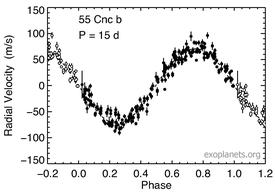| Revision as of 18:08, 8 January 2014 editTrappist the monk (talk | contribs)Administrators480,013 editsm Fix CS1 deprecated date parameter errors (test) using AWB← Previous edit | Revision as of 21:46, 28 June 2014 edit undoArtman40 (talk | contribs)2,039 edits →Orbit and massNext edit → | ||
| Line 68: | Line 68: | ||
| 55 Cancri b is in a short-period orbit, though not so extreme as that of the previously detected hot Jupiter ]. The orbital period indicates that the planet is located close to a 1:3 ] ] with ], however investigations of the planetary parameters in a Newtonian simulation indicate that while the orbital periods are close to this ratio, the planets are not actually in the resonance.<ref name=fischer /> | 55 Cancri b is in a short-period orbit, though not so extreme as that of the previously detected hot Jupiter ]. The orbital period indicates that the planet is located close to a 1:3 ] ] with ], however investigations of the planetary parameters in a Newtonian simulation indicate that while the orbital periods are close to this ratio, the planets are not actually in the resonance.<ref name=fischer /> | ||
| In 2012, b's upper atmosphere was observed transiting the star; so its inclination is about 85 degrees, coplanar with e.<ref name="transitatmo" /> | In 2012, b's upper atmosphere was observed transiting the star; so its inclination is about 85 degrees, coplanar with e. This helped to constrain the mass of the planet but the inclination was too low to constrain its radius.<ref name="transitatmo" /> | ||
| The mass is about .85 that of Jupiter.<ref name="transitatmo" /> | The mass is about .85 that of Jupiter.<ref name="transitatmo" /> | ||
Revision as of 21:46, 28 June 2014
Template:Planetbox begin Template:Planetbox star Template:Planetbox orbit Template:Planetbox character Template:Planetbox discovery Template:Planetbox catalog Template:Planetbox reference Template:Planetbox end

55 Cancri b (abbreviated 55 Cnc b and occasionally referred to as 55 Cancri Ab in order to distinguish it from the star 55 Cancri B) is an extrasolar planet orbiting the Sun-like star 55 Cancri A every 14.65 days. It is the second planet in order of distance from its star, and is an example of a hot Jupiter, or possibly rather "warm Jupiter". Discovered in 1996 by Geoffrey Marcy and R. Paul Butler, 55 Cancri b was the fourth known extrasolar planet, excluding pulsar planets.
Discovery

Like the majority of known extrasolar planets, 55 Cancri b was discovered by detecting variations in its star's radial velocity caused by the planet's gravity. By making sensitive measurements of the Doppler shift of the spectrum of 55 Cancri A, a 15-day periodicity was detected. The planet was announced in 1996, together with the planet of Tau Boötis and the innermost planet of Upsilon Andromedae.
Even when this inner planet, with a mass at least 78% times that of Jupiter was accounted for, the star still showed a drift in its radial velocity. This eventually led to the discovery of the outer planet 55 Cancri d in 2002.
Orbit and mass
55 Cancri b is in a short-period orbit, though not so extreme as that of the previously detected hot Jupiter 51 Pegasi b. The orbital period indicates that the planet is located close to a 1:3 mean motion resonance with 55 Cancri c, however investigations of the planetary parameters in a Newtonian simulation indicate that while the orbital periods are close to this ratio, the planets are not actually in the resonance.
In 2012, b's upper atmosphere was observed transiting the star; so its inclination is about 85 degrees, coplanar with e. This helped to constrain the mass of the planet but the inclination was too low to constrain its radius.
The mass is about .85 that of Jupiter.
Characteristics
55 Cancri b is a gas giant with no solid surface. The atmospheric transit has demonstrated hydrogen in the upper atmosphere.
That transit is so tangential, that properties such as its radius, density, and temperature are unknown. Assuming a composition similar to that of Jupiter and that its environment is close to chemical equilibrium, 55 Cancri b's upper atmosphere is predicted to be cloudless with a spectrum dominated by alkali metal absorption.
The atmosphere's transit indicates that it is slowly evaporating under the sun's heat. The evaporation is slower than that for previously studied (hotter) hot Jupiters.
The planet is unlikely to have large moons, since tidal forces would either eject them from orbit or destroy them on short timescales relative to the age of the system.
See also
Template:Misplaced Pages books
References
- ^ "Astrophile: First puffy, 'warm Jupiter' spotted - space - 12 October 2012". New Scientist. Retrieved 2012-11-09.
- Butler; Marcy, Geoffrey W.; Williams, Eric; Hauser, Heather; Shirts, Phil; et al. (1997). "Three New 51 Pegasi-Type Planets". The Astrophysical Journal. 474 (2): L115 – L118. Bibcode:1997ApJ...474L.115B. doi:10.1086/310444.
{{cite journal}}: Explicit use of et al. in:|author=(help) - Cite error: The named reference
fischerwas invoked but never defined (see the help page). - ^ Cite error: The named reference
transitatmowas invoked but never defined (see the help page). - Sudarsky, D.; et al. (2003). "Theoretical Spectra and Atmospheres of Extrasolar Giant Planets". The Astrophysical Journal. 588 (2): 1121–1148. arXiv:astro-ph/0210216. Bibcode:2003ApJ...588.1121S. doi:10.1086/374331.
{{cite journal}}: Explicit use of et al. in:|author=(help) - Barnes, J., O'Brien, D. (2002). "Stability of Satellites around Close-in Extrasolar Giant Planets". The Astrophysical Journal. 575 (2): 1087–1093. arXiv:astro-ph/0205035. Bibcode:2002ApJ...575.1087B. doi:10.1086/341477.
{{cite journal}}: CS1 maint: multiple names: authors list (link)
External links
- Jean Schneider (2011). "Notes for Planet 55 Cnc b". Extrasolar Planets Encyclopaedia. Retrieved 8 October 2011.
- Extrasolar Visions: 55 Cancri b
| The 55 Cancri system | |
|---|---|
|
| Known celestial objects within 20 light-years | |||||||||||||||||||||||||||||||||||||||||||
|---|---|---|---|---|---|---|---|---|---|---|---|---|---|---|---|---|---|---|---|---|---|---|---|---|---|---|---|---|---|---|---|---|---|---|---|---|---|---|---|---|---|---|---|
| |||||||||||||||||||||||||||||||||||||||||||
| |||||||||||||||||||||||||||||||||||||||||||
| |||||||||||||||||||||||||||||||||||||||||||
| |||||||||||||||||||||||||||||||||||||||||||
| Italic are systems without known trigonometric parallax. | |||||||||||||||||||||||||||||||||||||||||||
